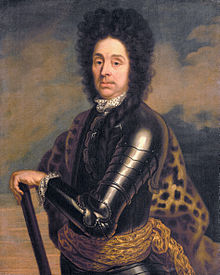Menno van Coehoorn
Menno Baron van Coehoorn (pronounced ku-; * March 1641 in Britsum, Province of Friesland ; † March 17, 1704 in The Hague ) was a Dutch artillery general , fortress builder and author of fortress-related works.
Life
Menno van Coehoorn was made captain at the age of 16. In 1673 he took part in the defense of Maastricht , which was besieged and conquered by French troops. He also took part in the siege of Grave. Small mortars that he had invented were first used in 1673.
Because of his bravery shown in the Battle of Seneffe (August 11, 1674), he was promoted to colonel that same year . Ultimately, he achieved the position of lieutenant general and inspector of the fortresses of the Dutch States General .
In 1680 troops led by him conquered the fortress Coevorden (province of Drenthe ), which he then had renewed. During the siege of Namur in 1692 by French troops under the leadership of Sébastien Le Prestre de Vaubans , among others , he led the defense of the city. In 1695 he was part of the evening command in the siege to retake the city. In Germany , too, his advice led to successful sieges. a. the Rhenish fortresses of Kaiserswerth ( April to June 1702 ) and Bonn 1703.
Van Coehoorn's works have long been decisive for the construction of Dutch fortifications ( Coehoorn's fortification manner ). His work on fortress construction in the lowlands was a widely read book well into the 19th century. In 1698 the Palatinate Elector Johann Wilhelm commissioned him to plan the reconstruction of the destroyed Mannheim fortress . His ideas were put into practice from 1699 onwards.
The portable Coehoorn mortar developed by van Coehoorn and named after him was still used in the American Civil War , in some cases even in the trench warfare of the First World War .
His Meerenstein Castle on the edge of the Frisian village Wyckel (now part of the municipality of De Fryske Marren in the province of Holland ) was demolished in 1811. The twelve-hectare castle park, which was laid out on his behalf around 1680, is known today as Menno van Coehoornbos . In 1949, the It Fryske Gea nature conservation association bought the French-style forest because it is valuable from a botanical and historical point of view as well as a recreational area. Special stinzen plants (palace garden flora) can be found on the site . From the eastern edge of the forest you have a beautiful view of the land and the Slotermeer.
Van Coehoorn's tomb is in the Dutch Reformed Church of Wyckel .
Works
- Versterkinge des vijfhoeks met alle sijne buytenwerken . Leeuwarden 1682.
- Nieuwe vestingbouw op en natte of lage horizont . Leuwarden 1685 (some reprints from 1702). The book was also published in other languages: English (London, 1705), French (Wesel, 1705), German (Düsseldorf 1709).
literature
- Coehoorn, Menno van . In: Meyers Großes Konversations-Lexikon . 6th edition. Volume 4, Bibliographisches Institut, Leipzig / Vienna 1906, p. 211 .
- Coehoorn, Menno, Baron van . In: Encyclopædia Britannica . 11th edition. tape 6 : Châtelet - Constantine . London 1910, p. 40 (English, full text [ Wikisource ]).
Web links
- Website of the Dutch Menno van Coehoorn Foundation for the Preservation of Former Defense Works (Dutch)
Individual evidence
- ^ Hartwig Neumann : Fortress architecture and fortification technology. German defense architecture from the 15th to the 20th Century . Bernard & Graefe Verlag, Bonn 1988, p. 159
- ^ Bernhard von Poten : Concise dictionary of the entire military sciences . 1879, Textarchiv - Internet Archive
- ^ Bernhard von Poten : Concise dictionary of the entire military sciences . 1879, p. 77, Textarchiv - Internet Archive
- ↑ Hans Linnenkohl: From the single shot to the fire roller . Bernard & Graefe Verlag Bonn 1996, ISBN 3-7637-5966-2
- ↑ Monument Number: 15,938th Rijksdienst voor het Cultureel Erfgoed, Monument Register
| personal data | |
|---|---|
| SURNAME | Coehoorn, Menno van |
| ALTERNATIVE NAMES | Coehoorn, Menno Baron van (full name) |
| BRIEF DESCRIPTION | Dutch artillery general and fortress expert |
| DATE OF BIRTH | March 1641 |
| PLACE OF BIRTH | Britsum, Friesland Province |
| DATE OF DEATH | March 17, 1704 |
| Place of death | The hague |

